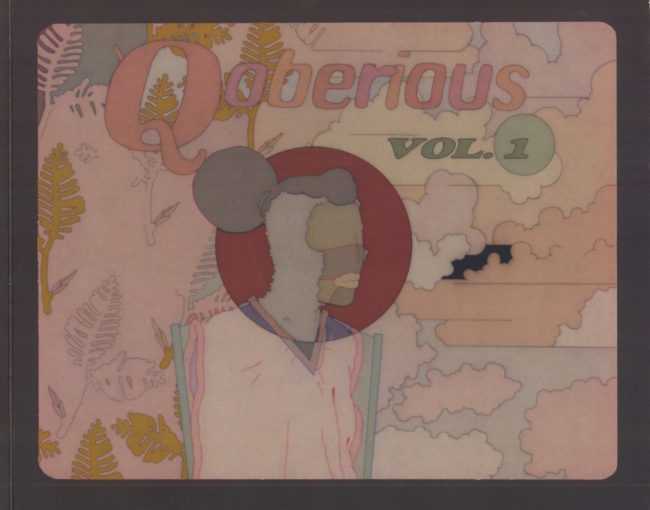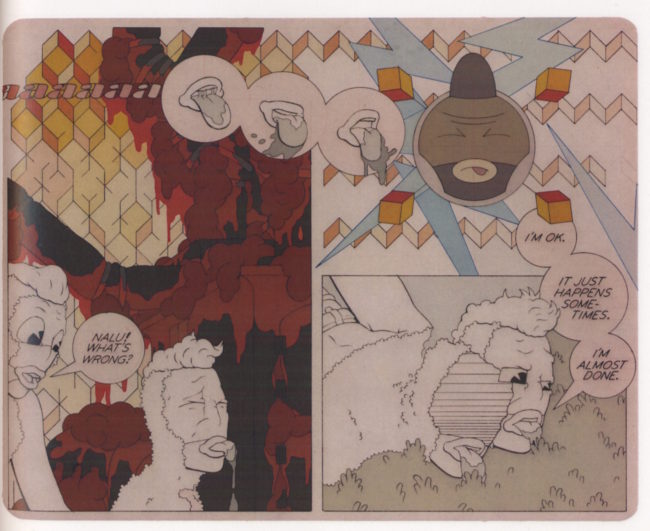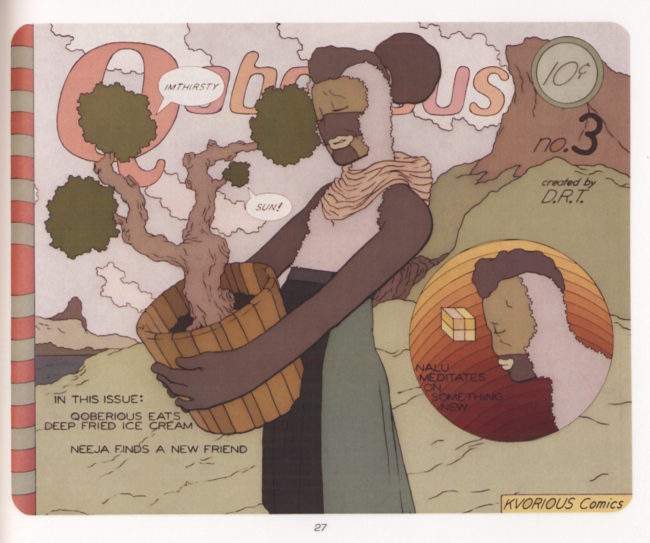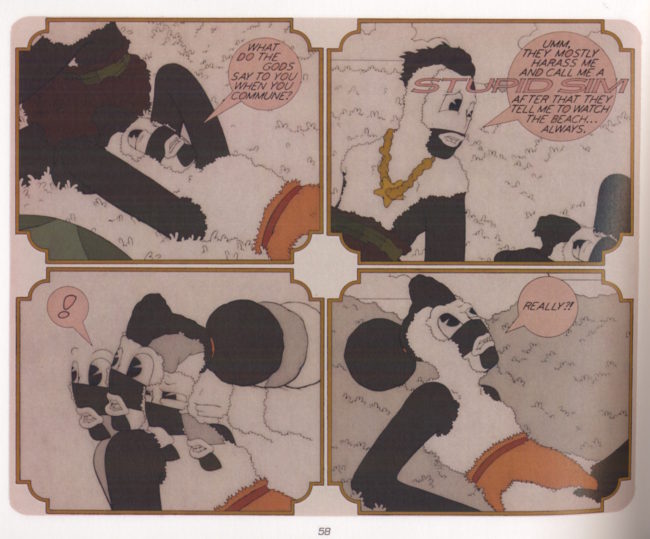
I’ve been holding on to Qoberious #1 since earlier this year, trying figure out what to make of it. The book came essentially out of nowhere fully formed, which defies my general expectations of comics-making. When a cartoonist publishes a graphic novel, especially when it’s a first graphic novel, there is often proceeding material, either zines or webcomics. DRT, the creator of Qoberious, sent the book to me and a list of small press critics in February/March, and in in the spring this generated a flurry of activity around the book; an interview and a review at TCJ, a feature at Daily Grindhouse, to name a few. This flurry of coverage seems to have led to more cartooning work – DRT will have a selection in Fantagraphics’ new anthology NOW #5, which is out this week. (You can read my review of the first volume here)
How Qoberious #1 caught on in certain circles seems fairly obvious, in hindsight. Most important is DRT’s expressive, Fleischer-inspired cartooning, which I will discuss later. But there’s also a human element that is striking; DRT, a young Seattle-based cartoonist, had a massive stroke in their 20s and lost the use of their dominant drawing hand. Qoberious #1 is the result of intensive rehabilitative labor, a comic that is directly linked to the suffering and debilitating after-effects of a stroke. Comics as therapy, or triumph over disability is a story people like to hear, and want to hear.
Importantly, that stroke still lives on the page, referenced throughout the comic as rope that binds up characters. Trauma and incapacitation appear throughout the book; these thematic images are just some of a plethora of symbolic elements seen throughout Qoberious #1. The book operates as a sort of mythical allegory that often defies easy explanation; what you see on the page is certainly not what you get.
Qoberious #1 seems to be a book about a pair of simulacra named Neeja and Nalu, part woolly sheep, part humanoid, living in kind of constructed fictional world. The two are tasked with guarding a specific part of that construction, and Nalu can “hear the word of God” by using a pseudo-spiritual ritual meditation, which often contains sexual elements. There’s bondage, roleplaying, fur-suits with dicks, all used in erotic yet esoteric ways. We also see the two simulacra interacting with geometric shapes, which in some ways act as a sort of porthole for an overseer race to observe what the simulacra are doing. These overseers look like giant eggs with faces and legs, and are often drawn looking clumsy and lazy.
All of these characters rest on top of a lot of formal experimentation; panels are often conjoined bubbles or clouds, and the materials from one row or block easily fall out into others. DRT is interested in the way that repetition affects meaning; duplication and layering give much of Qoberious #1 the same feeling you get when you listen to a group of singers sing a round. Qoberious #1 is an identical melody, started at different times, creating wave after wave of sound. There’s also an interesting effect in Qoberious #1 where DRT removes the linework on some of the pages, giving them all a faded feeling, like they are color layers stored in a library’s old microfiche collection. The whole book has a muted, faded color palette; that imitated antiquity is a linkage to older cartoons, which I’m certain is DRT’s goal. That muted look and the “lossy” view that the book sometimes has makes me feel as though I’m looking at these characters through a telescope. On nights when the sky is clear, everything is crisp and vivid; on cloudy nights, only an impression of the object behind them is visible.
Importantly there’s not much in a way of plot – Qoberious #1 works more off of an intense feeling and an unidentifiable propulsion. The characters of the book slowly build up a sense of person over time due to an accumulation of moments and conversations, snippets viewed across space and time. The proposition of Qoberious #1 is that it’s intentionally opaque, but a work of art that can be revisited many times, each time to different effect. I found the comic heady and confusing, but a rewarding read. There’s a lot going on here, and I doubt I caught half.
If you liked this review, please support the site on Patreon! Your support keeps the site ad-free and helps make the work I’m doing possible. Thanks!
(Thanks to RJ Casey for the images of the book, which I have shamelessly “borrowed” from his interview at TCJ. Apologies, my scanner is on the fritz.)




One response to “Review: Qoberious #1, by DRT”
[…] and sexual imagery overtop of intense formal experimentation made it a puzzling read. I wrote an entire review of the book at the beginning of December, and it’s possibly one of the most complicated books I’ve read. Still, I found the experience […]